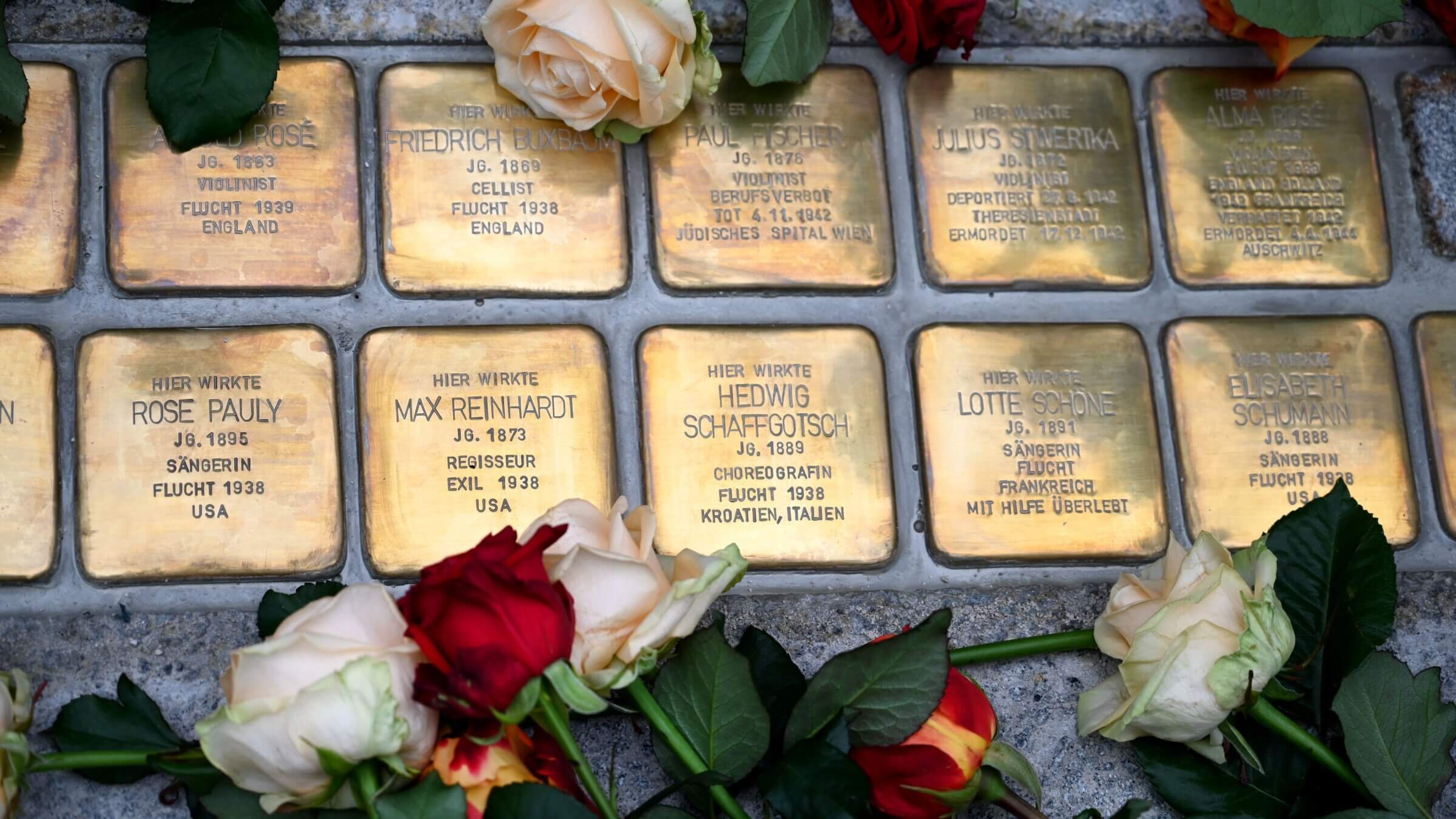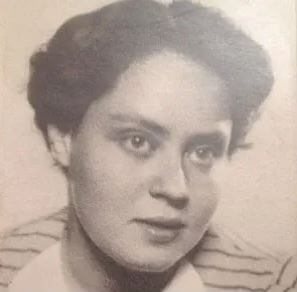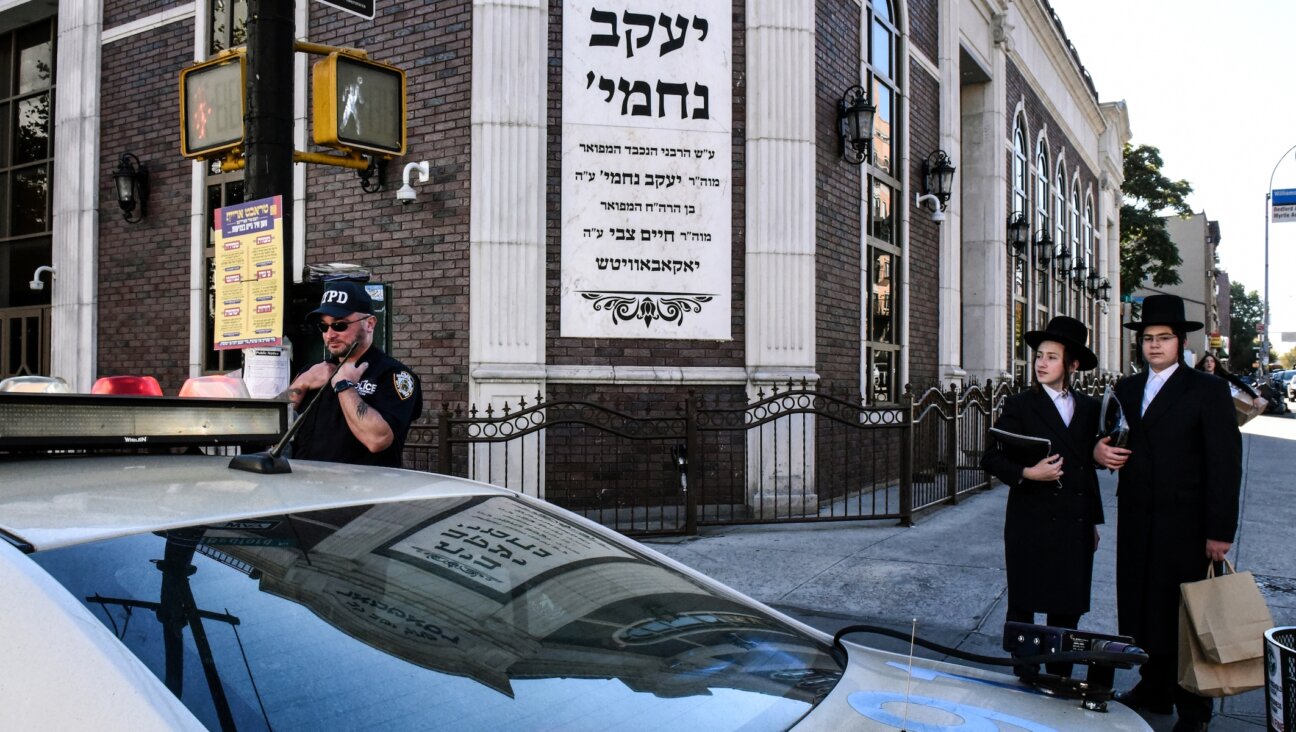England’s first Holocaust ‘stumbling stone’ will honor a woman who tried to rescue her family
Ada van Dantzig, who studied painting conservation in London, was killed at Auschwitz in 1943

Stumbling stones commemorating artists in Salzburg, Austria. Photo by BARBARA GINDL/APA/AFP via Getty Images

The U.K. is getting its first, and probably only, “stumbling stone” Holocaust memorial on Monday.
In German, it’s called a “stolperstein,” and is part of a project to commemorate victims of the Holocaust with a small cobblestone and a brass plaque at the person’s last known home or place of work. Since the project began in 1992, more than 100,000 stones have been placed in 26 countries across Europe, though none in the U.K., which was never occupied by the Nazis.
But project organizers felt an exception should be made to memorialize Ada Dantzig, a Dutch Jew who came to London to study, and returned to the Netherlands to help her family flee the Nazis. She instead was captured and killed in Auschwitz.
In London’s Soho neighborhood, the stolperstein for Dantzig will be laid in front of 3 Golden Square, the former studio of Helmut Ruhemann, with whom she studied painting conservation. The ceremony will take place after nearly two years of delays due to the COVID-19 pandemic.
Organizers of the project said there were few people, who, like Dantzig, left the U.K. to rescue relatives and then were themselves killed in the Holocaust, so it will likely be the country’s only stumbling stone.
The creator of the stolperstein project, Gunter Demnig, a German artist, calls the cobblestones “stumbling stones” because they are designed to slightly catch your feet, though they are flush with the pavement surface.
“You won’t fall,” Denmig told CNN in 2018. “But if you stumble and look, you must bow down with your head and your heart.”
He began the project as a one-off installation in memory of Sinti and Roma people. Thirty years later, the project is the world’s largest decentralized Holocaust memorial.
Dantzig and all her relatives, except for one brother, were deported to Auschwitz, where she and her parents were murdered on Feb. 14, 1943. A sister had been killed there two weeks earlier, and a brother was killed there two months later.
Demnig often quotes the Talmudic saying: “A person is only forgotten when his or her name is forgotten,” according to a statement from the Wiener Holocaust Library in London. “With this Stolperstein, Ada van Dantzig’s name, inscribed into the urban landscape of Soho, will be remembered.”
The Forward is free to read, but it isn’t free to produce

I hope you appreciated this article. Before you go, I’d like to ask you to please support the Forward.
Now more than ever, American Jews need independent news they can trust, with reporting driven by truth, not ideology. We serve you, not any ideological agenda.
At a time when other newsrooms are closing or cutting back, the Forward has removed its paywall and invested additional resources to report on the ground from Israel and around the U.S. on the impact of the war, rising antisemitism and polarized discourse.
This is a great time to support independent Jewish journalism you rely on. Make a gift today!
— Rachel Fishman Feddersen, Publisher and CEO
Support our mission to tell the Jewish story fully and fairly.
Most Popular
- 1

Fast Forward Ye debuts ‘Heil Hitler’ music video that includes a sample of a Hitler speech
- 2

Opinion It looks like Israel totally underestimated Trump
- 3

Culture Cardinals are Catholic, not Jewish — so why do they all wear yarmulkes?
- 4

Fast Forward Student suspended for ‘F— the Jews’ video defends himself on antisemitic podcast
In Case You Missed It
-

Culture Should Diaspora Jews be buried in Israel? A rabbi responds
-

Fast Forward In first Sunday address, Pope Leo XIV calls for ceasefire in Gaza, release of hostages
-

Fast Forward Huckabee denies rift between Netanyahu and Trump as US actions in Middle East appear to leave out Israel
-

Fast Forward Federal security grants to synagogues are resuming after two-month Trump freeze
-
Shop the Forward Store
100% of profits support our journalism
Republish This Story
Please read before republishing
We’re happy to make this story available to republish for free, unless it originated with JTA, Haaretz or another publication (as indicated on the article) and as long as you follow our guidelines.
You must comply with the following:
- Credit the Forward
- Retain our pixel
- Preserve our canonical link in Google search
- Add a noindex tag in Google search
See our full guidelines for more information, and this guide for detail about canonical URLs.
To republish, copy the HTML by clicking on the yellow button to the right; it includes our tracking pixel, all paragraph styles and hyperlinks, the author byline and credit to the Forward. It does not include images; to avoid copyright violations, you must add them manually, following our guidelines. Please email us at [email protected], subject line “republish,” with any questions or to let us know what stories you’re picking up.













